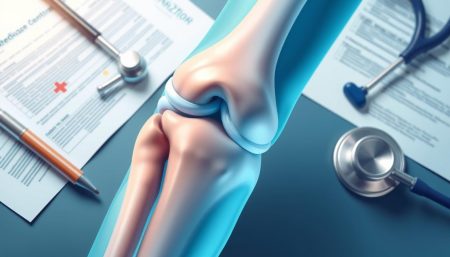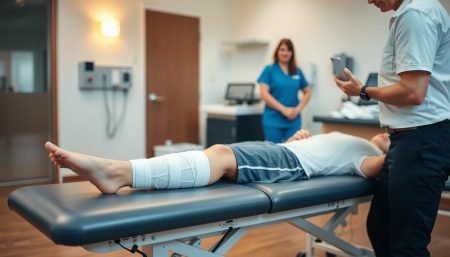Starting your journey with knee replacement surgery often begins with a simple question: “How long will it take?” This question is not just about time. It’s about the hope for better mobility and less pain. In this guide, we’ll explore the duration of knee replacement surgery, the knee surgery recovery process, and what to expect during the total knee arthroplasty procedure time.
This guide is more than just a timeline. It’s a supportive journey, filled with knowledge at every step. From getting ready for surgery to the slow but steady recovery—each part shows your strength and courage. We’re here to guide you, inform you, and support you every step of the way towards better health.
Keep reading as we break down the details of the procedure. We want to make sure you have a clear plan. Together, we’ll move forward, embracing wellness with every step.
Understanding Knee Replacement Surgery
Knee replacement surgery helps patients with severely damaged knee joints. It restores mobility and eases pain. The surgery uses different techniques based on each patient’s needs. Advances in technology have improved these procedures, making recovery faster and outcomes better.
This section explains what knee replacement surgery is, its goals, and the types available. You’ll learn about total knee arthroplasty and partial knee replacement.
What Knee Replacement Entails
Knee replacement surgery, also known as arthroplasty, replaces damaged knee parts with artificial ones. These parts are made of metal, ceramic, or plastic. They’re designed to move like a healthy knee.
It’s important for patients to understand the details of knee surgery procedures. This knowledge is key for those considering this life-changing option.
The Goal of Knee Replacement
The main goal of knee replacement surgery is to relieve pain and improve knee function. It’s recommended after other treatments, like medication or physical therapy, have failed. The aim is to enhance the patient’s quality of life.
Whether it’s a total knee arthroplasty or a partial knee replacement, the goal is the same. It’s to make the knee work better and feel less painful.
Types of Knee Replacements
There are two main types of knee replacements:
- Total Knee Arthroplasty: This involves removing and replacing all weight-bearing surfaces of the knee. It’s for those with advanced arthritis or significant damage.
- Partial Knee Replacement: Also known as unicompartmental knee replacement, it replaces only the damaged part of the knee. It’s for patients with damage in just one part of the knee. This option is less invasive and can lead to quicker recovery.
Choosing between these two types depends on several factors. These include the extent of knee damage, overall health, and lifestyle needs. Each type has its own benefits and recovery times. It’s important to discuss these with a healthcare provider.
Preparation for Knee Replacement Surgery
Getting ready for knee surgery is a big job. It involves many steps, from tests before surgery to changes in your daily life. It’s also important to plan your hospital stay for a smooth experience.
Pre-surgical Assessments
Before surgery, you’ll go through pre-operative assessments. These tests check your health and get you ready for surgery. Here’s what these assessments usually include:
- A physical check to see how your knee is doing and your overall health.
- Blood tests to make sure you’re healthy enough for surgery and anesthesia.
- Imaging tests like X-rays or MRIs to see inside your knee.
- A heart check, if needed, to make sure you can handle surgery.
Necessary Lifestyle Adjustments
Before surgery, you’ll need to make some lifestyle changes. These changes help you get ready for surgery and make recovery easier. Here are some things to consider:
- Stop smoking to help your body heal faster.
- Drink less alcohol to avoid surgery problems.
- Eat well to support your health and recovery.
- Start or keep exercising to get stronger and more flexible.
Planning Your Hospital Stay
Planning your hospital stay is part of preparing for knee surgery. You’ll usually stay a few days, depending on your surgery and how quickly you recover. Here are some things to pack:
| Item | Reason |
|---|---|
| Personal identification and medical documents | Important for hospital admission and medical care. |
| Comfortable clothing | For comfort during your stay and after you go home. |
| Toiletries | For personal hygiene during your hospital stay. |
| Prescription medications | To keep taking your regular treatments. |
By following these steps and preparing well, you can have a better surgery and recover faster.
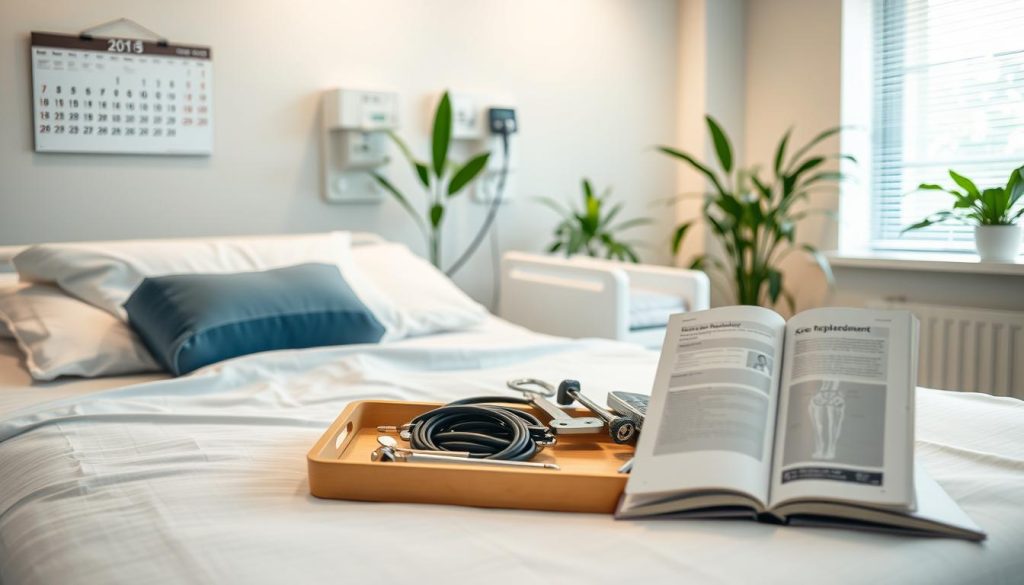
Breaking Down Knee Surgery Duration
Knowing the knee surgery duration is key for those about to undergo this surgery. The knee surgery operating time can change a lot. This depends on the surgery type and the patient’s needs. Let’s look at the expected times and steps in knee replacement surgeries.
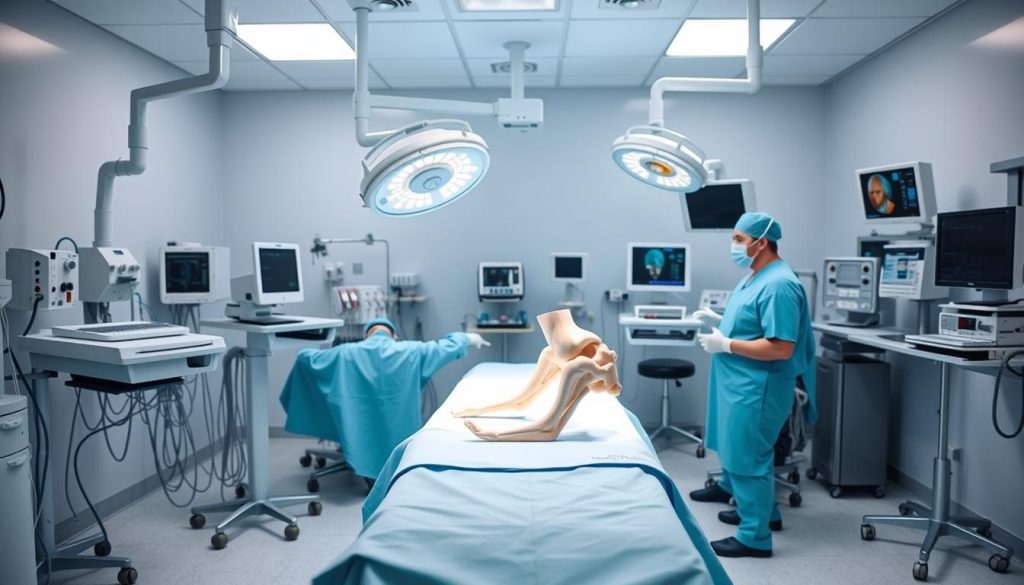
The knee replacement process timeline has several stages. It starts with getting ready before surgery and goes through the surgery itself and aftercare. Here’s a simple timeline:
| Phase | Duration | Description |
|---|---|---|
| Pre-operative Preparation | 1-2 weeks | Involves assessments and pre-surgery instructions. |
| Surgical Procedure | 1-2 hours | Actual replacement of the knee joint components. |
| Post-operative Care | 3-5 days | Initial recovery and monitoring in the hospital. |
| Rehabilitation | 3-6 months | Physical therapy and gradual return to activities. |
For more detailed info, check out this knee replacement guide at Mayo Clinic.
Talking to your doctor about the knee surgery operating time and recovery is vital. It helps set realistic goals and plan ahead. Knowing the knee replacement process timeline also prepares you mentally and practically for what’s next.
The Total Knee Arthroplasty Procedure Explained
For those thinking about knee replacement surgery, knowing the details can ease worries. This part explains the knee surgery process. It covers the steps of total knee replacement and the special equipment used.
Step-by-Step Surgery Process
The journey to better mobility starts with careful planning and precise steps. Here’s a detailed look at the main steps:
- Preparation: The area around the knee is cleaned and ready for surgery.
- Anesthesia: Anesthesia is given to keep the patient comfortable during the surgery.
- Incision: A careful incision is made to access the knee joint.
- Reshaping: Damaged bone and cartilage are removed and reshaped for the artificial joint.
- Implant positioning: The artificial parts are placed and secured to mimic natural knee movement.
- Sealing: The incision is closed with stitches and the area is bandaged.
- Recovery: The patient is monitored and supported as they wake up and start to move again.
Equipment Used During Surgery
Advanced tools and technology are key to precise and effective knee replacement surgeries. Here are some important pieces of equipment:
- Scalpels: For making the incision.
- Bone Saws and Drills: Needed for reshaping the bone to fit the prosthetic parts.
- Retractors: Used to keep the incision open for better visibility and access.
- Implant Components: Include the femoral, tibial, and patellar parts, made from materials like titanium and polyethylene.
- Sutures and Staplers: For closing and securing the surgical wound.
Knowing about these tools helps patients feel more confident about the high precision and safety standards in the procedure.

Knee Replacement Hospital Stay
Knowing about the knee replacement hospital stay duration and what to expect during hospital recovery after knee surgery is key for patients. This part talks about how long you’ll stay in the hospital and the care you’ll get to help you heal.
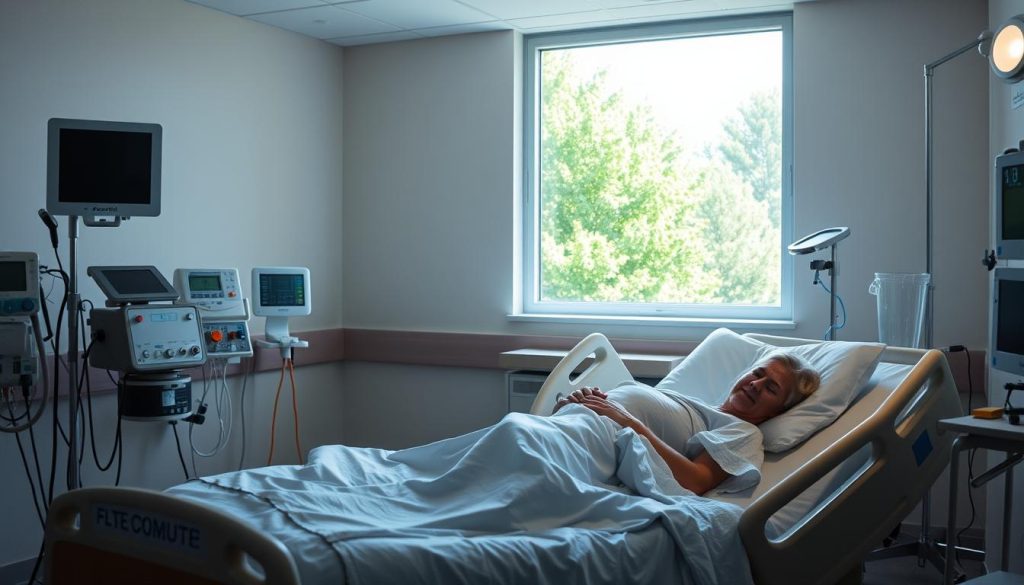
How long you’ll stay in the hospital after knee surgery varies. Usually, it’s between one to four days. The care you get during this time is very important for a good recovery.
- Personalized rehabilitation plans
- Routine postoperative care including pain management and wound care
- Access to multidisciplinary teams including physiotherapists and occupational therapists
Every patient gets special support to help them recover well. The goal is to manage pain, avoid problems, and help you move around.
| Day after Surgery | Activities | Support Services |
|---|---|---|
| Day 1 | Mobility testing with assistance | Nurse checks, pain management |
| Day 2 | Physiotherapy session | Nutritional guidance, wound care |
| Day 3-4 | Incremental walking, education on home care | Discharge planning, home adaptation guidelines |
Hospitals create a healing environment. They offer a series of services to help you recover and learn about keeping your joint healthy at home. They aim to keep your stay short while ensuring you recover well.
Day of Surgery: What to Expect
The journey through knee replacement surgery is detailed and starts when you arrive at the hospital. Knowing the knee surgery day-of procedures can help reduce your anxiety about the surgery.
Admission to Discharge
The surgery admission process is designed to be safe and efficient. First, you’ll have a health check to make sure you’re ready for surgery. This includes looking at your medical history, current medications, and a physical check-up. After that, you’ll go to the pre-operative area to prepare for anesthesia.
The Role of Anesthesia
Ensuring you don’t feel pain during the surgery is key. Anesthesia in knee replacement can be general or regional, depending on your health and the surgery’s length. Anesthesiologists watch your vital signs and adjust the anesthesia as needed during the surgery.
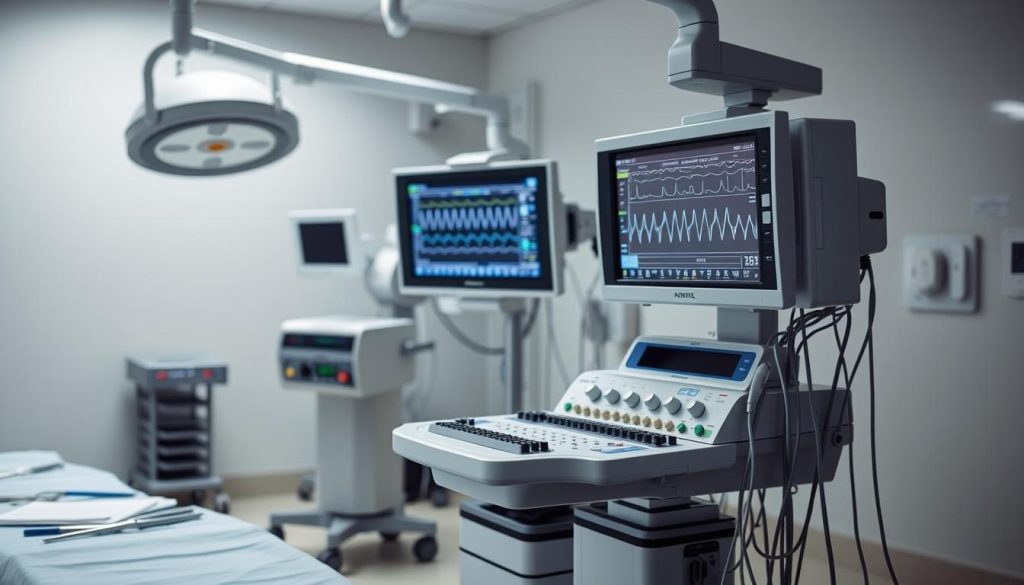
After surgery, you’ll go to the recovery room. The healthcare team will help you wake up from anesthesia. They’ll also watch over your recovery, making sure your pain is managed and you don’t have any complications.
| Time | Activity | Description |
|---|---|---|
| 07:00 AM | Arrival & Check-in | Patient registers at the surgery center, completes paperwork, and is admitted for surgery. |
| 07:30 AM | Pre-Op Assessment | A detailed examination by the surgical team verifying patient readiness and addressing final concerns. |
| 08:00 AM | Anesthesia Administration | Anesthesiology team administers the chosen type of anesthesia and ensures patient comfort. |
| 09:00 AM | Surgery | The surgical team performs knee replacement procedure. |
| 11:00 AM | Post-Op Recovery | Patient is monitored as they wake from anesthesia, with focus on pain management and initial recovery monitoring. |
How Long Does Knee Replacement Surgery Take
Patients often wonder about the duration of knee replacement surgery. The complexity of the joint, the surgery type (total or partial), and the surgeon’s skill are key. These factors affect the knee surgery operating time.
Knee replacement surgeries usually take 1 to 2 hours. But, when you add in prep and recovery, the whole process can take 2 to 4 hours.
| Stage | Duration | Details |
|---|---|---|
| Pre-operative preparations | 30-60 minutes | Involves patient setup, anesthesia administration, and surgical site preparation |
| Main Surgery | 1-2 hours | Depends on whether it’s a partial or total knee replacement and the complexity of the case |
| Post-operative procedures | 30-60 minutes | Involves wound cleaning, stitching, and initial recovery monitoring |
Knee surgery operating time can change due to medical reasons and new techniques. For example, new methods can make surgery shorter and recovery faster.
Knowing these times helps patients and families get ready for surgery. It’s good to talk about these times with your surgeon. Each case is different, with its own challenges and chances.
Postoperative Care in the Hospital
After knee surgery, getting care in the hospital is key for a smooth recovery. This time focuses on several important areas. These include immediate recovery, watching for complications, and managing pain well. Each part is essential for a patient’s journey after knee surgery.
Immediate Post-surgery Recovery
Right after surgery, doctors and nurses keep a close eye on patients. They check vital signs and watch for any signs of trouble. Good care in the hospital helps patients get better faster and stay safe.
Nurses and therapists help patients move from lying in bed to walking. They do this in a safe area of the hospital.
Pain Management Strategies
Managing pain after knee surgery is very important. It helps patients do their rehab better. Doctors use medicines, ice, and elevation to help with pain.
Teaching patients about their pain options helps them know what to expect. This makes their recovery easier.
The hospital’s care during this time is designed to support patients’ health. It helps them move smoothly from surgery to recovery.
Outpatient Knee Replacement: A Different Timeline
Knee surgery has seen big changes, including outpatient knee replacement. This method makes recovery faster, letting patients heal at home.
Only certain patients can have outpatient surgery. They must be healthy and not have serious health problems. This change is making orthopedic care better.
- Initial Consultation and Screening: Checking if the patient can have outpatient surgery.
- Pre-operative Education: Teaching patients what to expect and how to get ready for home recovery.
- Surgery Day: A quick process from start to finish on the same day.
- Post-operative Support: Planning for care and rehab at home.
These steps make the same-day knee surgery recovery process easy. Moving from hospital to home quickly helps patients feel more comfortable.
Embracing outpatient knee replacement reduces stress and disruption from traditional inpatient surgery.
Here’s a comparison of recovery times for inpatient and outpatient knee replacement:
| Aspect | Inpatient Knee Replacement | Outpatient Knee Replacement |
|---|---|---|
| Hospital Stay | 3-5 days | Same day |
| Initial Recovery | In hospital under medical supervision | At home, starting hours after surgery |
| Rehabilitation Start | 1-2 days after surgery | Right away when back home |
| Overall Recovery Period | Weeks to months | Shorter, depending on home care |
The outpatient knee replacement method changes recovery for the better. It shows how surgery and care have improved. This approach makes recovery faster and more personal.
Partial Knee Replacement Timeline
Looking into the partial knee replacement process shows its unique benefits. It’s a less invasive surgery that targets only the damaged part of the knee. This can lead to quicker recovery times. Knowing what to expect from surgery to full mobility is key for those thinking about it.
Differences from Total Knee Replacement
Partial knee replacement is different from total knee replacement. It’s less invasive, shorter in time, and only replaces the damaged part of the knee. This means less risk and a quicker return to daily life.
Recovery Expectations
Recovery after surgery varies based on the patient, but there are common milestones. These include shorter hospital stays and a quicker start to light activities.
- Initial Healing: The first few weeks focus on managing pain and swelling.
- Mobility Milestones: Patients often start walking with aid right away. Driving may start after 3-4 weeks, based on pain and mobility.
- Physical Therapy: Starts soon after surgery to strengthen the knee and improve flexibility.
| Stage | Time Frame | Activities |
|---|---|---|
| Immediate Post-Op | 1-3 Weeks | Home recovery, walking aid use, basic knee exercises |
| Early Rehabilitation | 4-6 Weeks | Increased exercise, light household tasks, possible return to work |
| Advanced Rehabilitation | 6-12 Weeks | Driving, extended walking, return to most pre-surgery activities |
The partial knee replacement process is efficient and leads to quick recovery. It’s a better option for those who want a less invasive way back to their normal lives.
Knee Replacement Rehab Timeline
The journey through knee replacement rehab process is key for full recovery and mobility. It aims to strengthen the knee and improve movement. Knowing the rehab phases and physical therapy after knee surgery milestones helps patients understand their recovery better.
Phases of Rehabilitation
Rehab starts right after surgery. Here’s what it involves:
- Initial Phase (0-2 weeks): This stage focuses on reducing swelling, managing pain, and starting basic movements.
- Middle Phase (2-6 weeks): More exercises to build muscle strength and joint flexibility.
- Advanced Phase (6-12 weeks): More strength and flexibility exercises, and possibly starting outpatient physical therapy.
- Maintenance Phase (3-6 months): Continued recovery with exercises to return to normal activities and lifestyle.
The pace through these phases varies based on healing and therapy adherence.
Physical Therapy Milestones
Physical therapy is vital in the knee replacement rehab process. It has key milestones for full knee function:
- Week 1-3: Achieving 90 degrees of knee flexion.
- Month 1-2: Walking unaided and climbing stairs without help.
- Month 3: Starting low-impact sports activities.
- Month 6 and beyond: Returning to high-impact activities, if approved by a healthcare provider.
For more on restorative procedures that improve life post-surgery, look into full mouth dental implants.
Knowing the knee replacement rehab process and physical therapy after knee surgery milestones helps set realistic goals. It encourages active participation in recovery. By staying informed and engaged, individuals can improve their outcomes and return to daily activities with confidence.
Factors Impacting Knee Surgery Recovery Time
Knowing what affects recovery time after knee surgery is key for patients and their families. Many things can influence how fast someone can get back to normal after surgery. This includes the person’s health and the skill of the surgical team.
Individual Health Considerations
Every patient’s health is different and affects recovery time. Age, weight, physical health, and any health problems like diabetes can change how fast someone heals. For example, younger people or those without long-term health issues might heal faster.
Following the doctor’s advice, including physical therapy and taking medicine, is also very important. It helps a lot in getting better.
The Surgeon’s Skill and Experience
The skill of the orthopedic surgeon is very important for recovery. Doctors with lots of experience and training in knee surgery usually have fewer problems and faster recoveries. They do the surgery with great care, which helps the body heal better and faster.
Other things like the hospital’s environment and resources also play a part. Having the best tools and care facilities can help people recover faster.
| Factor | Impact on Recovery Time |
|---|---|
| Patient’s Age | Younger patients typically recover faster |
| Patient’s Overall Health | Better pre-operative health shortens recovery time |
| Surgeon’s Experience | More experienced surgeons may improve recovery outcomes |
| Post-Surgical Care | Effective rehabilitation essential for fast recovery |
Understanding these factors helps patients and doctors work together for better recovery. By knowing these points, people can prepare better for their recovery journey.
Physical Therapy and Knee Surgery Recovery
Recovering from knee replacement surgery is a long journey. Knee surgery physical therapy is a key part of this journey. It helps regain mobility and improve quality of life, whether in a hospital or at home.
Inpatient vs. Outpatient Therapy
The choice between inpatient vs outpatient rehab depends on where and when therapy starts. Inpatient rehab starts soon after surgery, with lots of care in the hospital. Outpatient rehab starts later, at home, and is more flexible.
Role of Therapy in Long-Term Recovery
Therapy for knee surgery recovery is essential for long-term success. It’s a team effort between the patient and therapist. Together, they work towards improving knee strength and flexibility.
Success stories in physical therapy can be very inspiring. They show that with hard work, anyone can get stronger. For more information on recovery, check out this resource.
FAQ
Q: What is the average duration of knee replacement surgery?
A: Knee replacement surgery usually takes one to two hours. But, it can take longer based on the case’s complexity and the type of replacement.
Q: What can patients expect during the knee surgery recovery process?
A: Recovery includes managing pain, physical therapy, and getting more mobile. It can take weeks to months to fully recover.
Q: How long do patients usually stay in the hospital after knee replacement surgery?
A: Hospital stays range from a few days to a week for inpatient surgery. Outpatient surgery might let you go home the same day, if recovery is smooth.
Q: What is involved in pre-surgical assessments and preparation for knee surgery?
A: Assessments include health checks, X-rays, and blood tests. You might need to stop certain meds and plan for post-surgery care.
Q: What are the differences between a total and a partial knee replacement?
A: Total knee replacement replaces the whole joint. Partial knee replacement fixes only the damaged part. Partial is less invasive and has a quicker recovery.
Q: Are there different types of equipment used during knee replacement surgery?
A: Yes, tools like bone saws and prosthetics are used. Monitoring equipment keeps patients safe during surgery.
Q: What is the typical knee surgery operating time?
A: Surgery usually lasts one to two hours. Time can vary based on the procedure’s complexity.
Q: Can knee replacement surgery be done on an outpatient basis?
A: Yes, for some patients, outpatient surgery is an option. It’s for those who are healthy and can start therapy right away.
Q: How does postoperative care differ in outpatient knee replacement?
A: Outpatient care focuses on quick pain relief and starting therapy right away. This allows for a same-day discharge.
Q: What factors impact knee surgery recovery time?
A: Recovery time depends on health, age, and fitness. The surgeon’s skill and following care plans also matter.
Q: How critical is physical therapy to knee surgery recovery?
A: Physical therapy is key for recovery. It helps with pain, mobility, and muscle strength. Both inpatient and outpatient therapy are important.
Q: What are the phases of rehabilitation in a knee replacement rehab timeline?
A: Rehab starts with simple exercises and progresses to more complex ones. It includes outpatient therapy and returning to normal activities.
Q: What is the role of therapy in the long-term recovery from knee replacement?
A: Therapy is vital for long-term recovery. It helps build strength and ensures patients can do everyday tasks and enjoy activities.
Q: How does the recovery from partial knee replacement differ from total knee replacement?
A: Partial knee replacement recovery is faster. It involves less pain, a shorter hospital stay, and quicker return to activities.
















